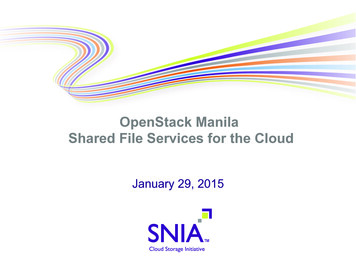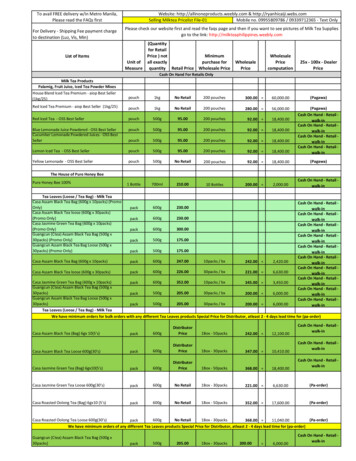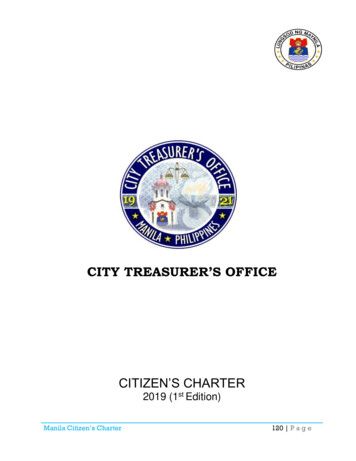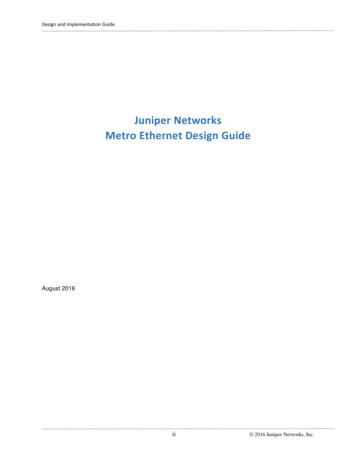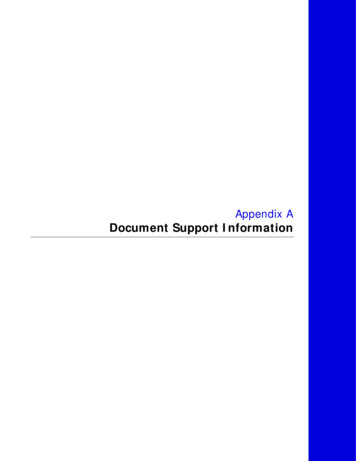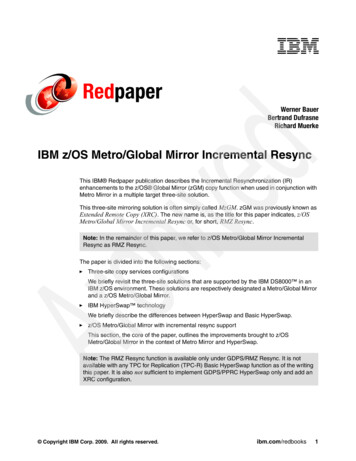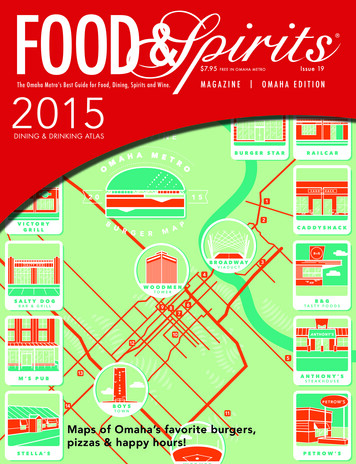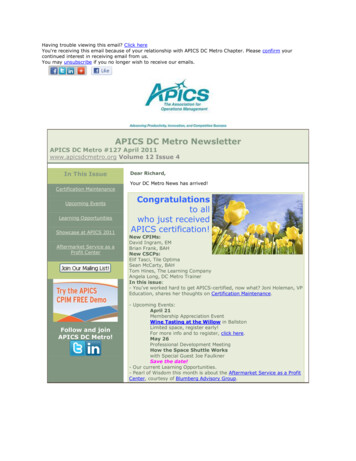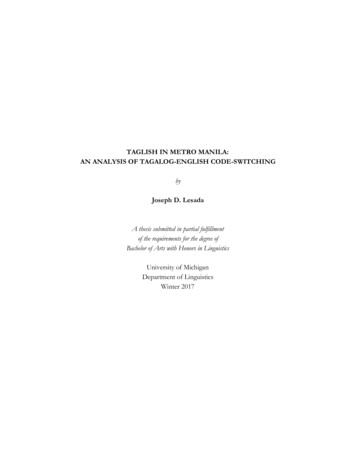
Transcription
TAGLISH IN METRO MANILA:AN ANALYSIS OF TAGALOG-ENGLISH CODE-SWITCHINGbyJoseph D. LesadaA thesis submitted in partial fulfillmentof the requirements for the degree ofBachelor of Arts with Honors in LinguisticsUniversity of MichiganDepartment of LinguisticsWinter 2017
1Para sa parents ko, dahil two languages ang binigyan nila sa akin.
2TABLE of CONTENTSAcknowledgement . . Abstract . Glossing Abbreviations .Map 1 . Introduction . 45678Chapter 1: The Contact Situation1.1Broad Overview of Taglish . 101.2A Brief Philippine History . 11A Note on Terminology . 131.3Current Language Situation . 141.4A Land of Linguistic Fluidity . 151.5The English and Tagalog Domains . 181.6Bilingualism and Diglossia . 20Chapter 2: Literature Review2.1Code-Switching Frameworks . 232.1.1 Myers-Scotton . 232.1.2 Muysken 282.1.3 Sankoff & Poplack . 302.1.4 Grosjean . 322.1.5 Gumperz . 342.2Taglish Scholarship . 352.2.1 Bautista . . 362.2.2 Goulet . . 39Summary . . . 40Chapter 3: Research3.1Methodology . . 413.2Data Analysis . . . 45A Note on Data Presentation . . 463.2.1 Tagalog Enclitics . . 463.2.2 Tagalog Conjunctions . . 503.2.3 English Content Morphemes . 513.2.4 EL Islands & ML Islands . . 533.2.5 Tagalog Tags . . 563.2.6 Mixed Noun Phrases . . 573.2.7 Mixed Verb Formation . . 583.2.7.1 Prefixed . . . 593.2.7.1 Prefixed with Reduplication . 613.2.7.1 Infixed . . . 643.2.7.1 Suffixed . . 66Summary . . . . 67
3Chapter 4: Key Findings4.1 ML Turnover . . . . 694.2 Range of Strategies . . . 714.1 SVO in Tagalog ML Frames . . 73Chapter 5: Conclusion . . . . 75Appendix A: Glossary of Tagalog Enclitics . . . 77Appendix B: Tagalog Phonology . . . 78Appendix C: Philippine English Phonology . . 79Appendix D: Data Corpus . . . 80Appendix E: Data Corpus Statistics . . . 83References . . . 84
4AcknowledgementForemost, my endless gratitude goes to my advisor, Marlyse Baptista, for her inspiring brilliance,unwavering commitment, and steady encouragement. I met Marlyse at an event during my first yearat Michigan, and the conversation I had with her solidified my desire to study the science oflanguage. I cannot express how thankful I am to have walked through this adventure with theguidance of such an incredible linguist and passionate human being.My sincere thanks to Professor Acrisio Pires for his excited willingness to support me in thisendeavor. To Professor Carmel O’Shannessy: thank you for helping me to see this data in a newlight. To Professor Sally Thomason: thank you for inspiring me to dive deep into the Philippinelanguage situation. To Professor Deirdre de la Cruz: thank you your feedback and for stirring withinme a love for the history ng Pilipinas. To Tita Zeny: marami maraming salamat po sa pagtuturo ng Tagalogsa akin!I am grateful for the incredible faculty and staff of the Linguistics department, including Dr. JenniferNguyen and Professor Ezra Keshet, who have supported me through this process.A special thank you to Dr. Carol Myers-Scotton, whose insight and intelligence are the pulse of thisresearch.Shout out to my cool aunt and uncle, Tita Lei and Tito Jon, who adopted me as I called Manilamy home for the summer of 2016— salamat sa lahat ng pagkain! To the eight ever-supportive men ofthe Manhood: living with you all is the best mistake I’ve ever made. And to the childhood barkadawho kept me grounded during the toughest parts of this project—I couldn’t imagine life orGroupMe without the belly laughter we share.I owe an enormous utang ng loob to my unbelievably selfless parents, Nonnie & Aidyl, and mysupportive sister and Ate , Hanniel. Thank you for your sacrifice, your truth, and your love. I wouldnot be here without you.Finally, and above all, I thank God for the life I have in Him.
5AbstractCode-switching is the mixing of two or more language varieties within a single utterance orconversation. This linguistic phenomenon is the basis of Taglish, the code-switching variety of thebilingual Tagalog-English community of Metro Manila, Philippines. Currently, general research oncode-switching is widely available, but our understanding of Tagalog-English code-switchingremains limited. This study examines the language contact situation in Metro Manila, synthesizesprevious code-switching scholarship from numerous authors, and analyzes a corpus of new Taglishdata collected in the Philippines in 2016. The present thesis demonstrates that Tagalog-Englishcode-switching patterns and strategies reveal the high linguistic proficiency of the Filipino bilingual.
6Glossing Abbreviations reduplication marker infix separationprefix/suffix connection1first person2second person3third personACTFOCactor focusADJadjectiveADVadverbBENbenefactive focusCAUScausativeCOMPcomparativeCOMPLcompletive aspectCONJconjunctionCONTcontemplative aspectDETdeterminerDEMdemonstrativeDIRdirect caseELEmbedded LanguageENCencliticEXexclusiveEXTexistential markerGENgenitive ctionINVinversion markerLKlinkerLOClocativeMLFMatrix Language FrameMLMatrix LanguageNEGnegation markerNnounNGgenNPnoun phraseOBoblique markerOBJFOCPHPLPOSSPMPREPPROQSGobject focusphrasepluralpossessivepossessive markerprepositionpronounquestionsingular
7Map 1: Tagalog-speaking region of the Philippines (pictured in dark grey).
8IntroductionThe linguistic phenomenon of code-switching refers to the mixing of two or more languagevarieties within a single utterance or conversation. Such a practice is common in the Republic of thePhilippines, a nation of vast linguistic diversity. In a combined land mass about equal in size to thestate of Arizona, some 170 languages—many mutually unintelligible—are spoken daily. Two ofthese languages have been given national status: Filipino (the standardized register of Tagalog) andEnglish (the language propagated during the American imperial era). Tagalog and English coexist ina complex and ever-evolving relationship; in the late 1960s, decades of contact resulted in theemergence of a widely-used Tagalog-English code-switching system: Taglish.Taglish has been described as “a very widespread predominantly spoken “mixed” languagevariety, whose phonology, morphology, syntax and semantics have been greatly influenced byEnglish and Tagalog” (Tangco and Ricardo 2002, 391). Taglish is common throughout theTagalog-speaking region of the Philippines and is largely considered “the normal acceptableconversation style of speaking and writing” (Goulet 1971, 83). Tagalog-English code-switching canalso be heard in Filipino diasporic communities across the Anglosphere. Since its emergence, thespeech system has become increasingly systematic and patterned; Taglish can be understood as aresult of several sociolinguistic factors (Thompson 2003: 40).The purpose of the present thesis is threefold:1) to consider the sociolinguistic and historical circumstances which gave rise to Taglish,2) to analyze the systematic code switches observed in Tagalog-English bilinguals, and3) to explain the factors which motivate speakers to switch between languages.Drawing on previous code-switching scholarship (work by Myers-Scotton, Muysken,Sankoff & Poplack, Grosjean, Gumperz), existing Taglish research (Bautista, Goulet), and my own
9fieldwork data from Manila Taglish, I hope to reach a more comprehensive, holistic understandingof Tagalog-English code-switching. Such conclusions could strengthen the field’s understanding ofbilingual competence, code-switching grammars, and sociolinguistics within the Philippines, andcould also provide direction to the increasingly challenging Philippine bilingual education policy.Though the science of linguistics has invested much in the study of general code-switchingas a bilingual phenomenon, relatively few linguists have examined the case of Taglish; thus, it is anecessary and worthy subject of further research.The purpose of Chapter 1 is to describe the current language contact situation within theTaglish-speaking regions of the Philippines, and to illuminate the historical, social, and culturalfactors which have allowed for such a variety to arise. From there, the literature review willsynthesize previous research done on code-switching and Tagalog-English bilingualism. Followingan explanation of my research methodology, I will offer an analysis of the corpus of Taglish data Ihave collected. Finally, I shall conclude with a number of key findings and implications for thefuture study of code-switching in Filipino-English bilinguals.
10Chapter 1The Contact Situation1.1. Broad Overview of TaglishAn English-speaking tourist stepping foot in Manila for the first time might be struck by theinescapable snippets of the English language throughout the diglossic Filipino society. Fromkindergarten classrooms and morning radio to political speeches and grocery store transactions,sound bytes of English words and phrases can be heard in almost every corner of Metro Manila.These recognizable pieces of English are the Filipino bilingual’s code-switching capacity at work.Taglish is visible in newspapers, audible in churches, and the norm on CNN Philippines.Taglish as a social phenomenon was first observed in the late 1960s, but became firmlyestablished following the enactment of the 1973 Bilingual Education Policy; the greatest increase inthe use of the code-switching variety took place over the fifteen years that followed, through 1988(Thompson 2003). Bonifacio Sibayan, a Filipino linguist, predicted in 1985 that the national languageof tomorrow would indeed be Taglish (Sibayan 1985). Today, Tagalog-English code-switching ismost commonly observed among the educated, middle- and upper-class urbanites of the Philippines.Furthermore, as a result of mass media, Taglish has exceeded the boundaries of theTagalog-speaking region, and is now characteristic of bilinguals outside the Metro Manila urbanreach. In my research, I have observed Taglish speakers as far as Tacloban, Leyte in the Waray- andCebuano-speaking Eastern Visayas, hundreds of miles from the capital. The code-switching systemhas also been mass exported via the Filipino diaspora, primarily to English-speaking countries suchas Australia, Canada, the United Kingdom, and the United States.
11Taglish is far more complex than basic borrowing and Taglicization of English terms; itinvolves frequent, patterned, systematic alternation between the two languages, including blendingcharacterized by the affixation of Tagalog grammatical elements to English lexical items and viceversa. The code-switching discourse has its own distinct rules and regularities, and the alternationsand insertions can occur in many places within the morpheme, word, or phrase levels. A 1993 studyrevealed that educated Filipino bilinguals “were employing—at the clause level—Filipino/Tagalog23% of the time, English 27%, and Filipino-English conversational code-switching variety 50%”(Tangco et al 2002). The same study found that word-level switches (both word-to-word andintraword) comprised nearly 50% of all Tagalog-English switches, while clause- and phrase-levelswitches constituted 21% and 31%, respectively.Some argue that the system is even beginning to show characteristics of a creole or mixedlanguage, as the lines between the languages become more blurred and young Filipinos grow upspeaking Taglish as a first language.1.2 A Brief Philippine HistoryTo fully grasp the origin of Taglish and the Filipino bilingual, it is necessary to zoom out andexamine the history of the Philippines and its centuries-long language contact situation. I believe thissection to be important, as a nuanced study of code-switching requires us to consider bothsociohistorical and linguistic factors.The southeast Asian islands which would become the Philippines were prehistorically settledby Austronesian-speaking peoples thousands of years ago. Portuguese explorer Ferdinand Magellanarrived on the island of Cebu in the Central Visayas in 1521; the archipelago was subsequentlyclaimed for the Spanish crown, beginning the 333-year colonization of Las Islas Filipinas , named for
12King Philip II. The territory’s tenure within the Spanish empire brought merchants and Catholicmissionaries to its shores, who catalyzed a dramatic and lasting impact on the lexicons of the islands’native languages. The Spaniards did not establish an educational system nor did they force theirsubjects to speak Spanish. This was decided under the belief that Filipinos would revolt againstSpain if they became ‘enlightened’ (Bernabe 1978). Thus, unlike Spain’s New World colonies,Spanish never became a lingua franca of the islands, but was, however, spoken by the upper crust ofsociety. Meanwhile, indigenous Philippine languages maintained their social dominance for theentirety of the Spanish era.Presently, Spanish is largely absent throughout the Philippines, surviving only throughthousands of lexical borrowings, within the Spanish and Spanish-Filipino mestizo populations, andthe family of Spanish-based creole languages collectively known as “Chabacano.” It is worth notingthat the Philippines had brief contact with the English language upon the capture of Manila by theBritish in 1762; Spain reclaimed the territory just two years later.Following the Spanish-American War of 1898, Spain ceded the Philippines to the UnitedStates. Subsequently, hundreds of English teachers were sent to the territory to educate andAnglicize the new American islands. President William McKinley designated English to be themedium of instruction for the Philippine public education system on April 7, 1900. In the decadesfollowing, English would spread rapidly throughout the archipelago.In 1937, in an effort to unite the Philippine islands as a nation-state, the colonial governmentdeclared the newly-coined “Pilipino” as the Pambansang Wika (national language). It was intended tobe a new, innovative Tagalog-based language which amalgamated lexical items from other majorPhilippine languages as well. In reality, this intent was never realized; to this day, the glossonyms
13‘Filipino’ and ‘Tagalog’ are essentially synonymous. This creation of an artificial-in-name,conglomerate national language—and its relation to English—is detailed by Smolicz and Nical:Even as late as 1971, the Constitutional Convention showed deep divisions of opinion and ahostility towards Pilipino—the name adopted for the “national” version of Tagalog. Theopposition to Tagalog/Pilipino was “so fierce that there was the danger that a foreignlanguage like English might be adopted as the Philippine national language” (Bautista 1981:6). In order to forestall such a possibility, the linguists and educators committed to Pilipinoresorted to a compromise involving an agreement to develop a national language throughthe fusion of all the languages of the Philippines, to give rise to a “multi-based” language tobe called Filipino. While this type of “universal approach” was sanctioned by the 1973constitution, it immediately engendered much skepticism, with Gonzales (1974) labelling itas “legal fiction”. This proved to be the case, since in the subsequent years the “enriched”Tagalog/Pilipino was adopted under the label of Filipino (Gonzalez 1996: 230) and assumedthe role of both a national and official language, sharing the latter title with English andSpanish,” (Smolicz and Nical 1997: 512).The Republic of the Philippines gained full sovereignty in 1946, following World War II and381 years of Western colonization. In 1973, English was made a national language, in addition to theTagalog-based Filipino language. Spanish was demoted from its official status in 1987, and withArabic, was recommended for use in education on an optional basis.A Note on TerminologyThough the official name of the national language is “Filipino” (formerly “Pilipino”), for thepurposes of linguistic analysis and simplicity, I will refer to the language as “Tagalog” whereappropriate, as it is the glossonym used by most Filipinos. I use “Taglish” and “Tagalog-Englishcode-switching” interchangeably. Though Filipinos may very well be proficient in any number oflanguages, I use “Filipino bilingual” to refer to speakers of at least Tagalog and English, i.e. amultilingual who speaks Tagalog, English, Spanish, and Kapampangan, and a bilingual who speaksonly Tagalog and English might both be referred to as a “Filipino bilingual.”
141.3 Current Language SituationThe Philippines remains a highly multilingual nation; approximately 170 languages arespoken by the nation’s 103,000,000 citizens. Of these, the most widely-spoken languages are:1.2.3.4.5.6.7.8.9.10.11.12.Filipino (Tagalog): 45,000,000 speakersEnglish: 40,020,000 speakersCebuano: 15,800,000 speakersIlokano: 7,016,400 speakersHiligaynon (Ilonggo): 5,770,000 speakersBicolano: 4,580,000 speakersWaray: 2,560,000 speakersKapampangan: 1,905,430 speakersPangasinense: 1,162,140 speakersMaguindanaon: 1,100,000 speakersTausug: 1,062,000 speakersMasbateño: 600,000 speakers(Ethnologue 2017)The differences between these languages are notable: many of them are mutuallyunintelligible. Curtis McFarland notes:The linguistic diversity of the Philippines arises from natural processes broadly relating tolanguage change, the divergence between linguistic communities caused by lack ofcommunication, and the converse convergence caused by a high rate of communicationbetween communities. The people of the Philippines are experiencing a period of languageconvergence, marked by high levels of borrowing from large languages such as English,Tagalog, as well as from regionally important languages. In this process, for better or worse,some languages are abandoned altogether and become extinct (McFarland 2004, 59).Here, McFarland notes that Philippine languages, by and large, are in a season ofconvergence. We can conclude that the emergence of a systematic Tagalog-English code-switchingsystem is one of numerous outcomes of this process.The Philippines is also home to numerous creole languages: a body of Spanish-lexifiedcreoles emerged throughout the archipelago during the 18th and 19th centuries and are still spokenwidely today. In addition, Hokaglish—a contact language derived from trilingual communities
15code-switching between Hokkien, Tagalog, and English—is used by more than 100,000 ChineseFilipinos (Gonzales, W. D. W. 2016).1.4 A Land of Linguistic FluidityThe Philippine case indicates a notable level of “linguistic fluidity.” By this, I mean thatFilipinos, historically and generally speaking, are inclined towards widespread linguistic pluralism andlanguage change as a result of factors such as geography, colonialism, religious conversion, culturalimperialism, and mass media. A central result of this phenomenon is a cultural trend towardlinguistic flexibility in Filipinos’ day-to-day conversations.To illustrate this idea, consider first the widespread multilingualism in the Philippines. Themany Austronesian languages native to the Philippines are a historic result of the multitude ofislands and often difficult, mountainous terrain within each island. Hundreds of distinctethnolinguistic groups arose over the course of thousands of years as a result of limited intra-islandcommunication. Over the past several hundred years, significant language contact, intranationalmovement, migration to the Philippines, and the growth of urban centers has resulted in a widelymultilingual and ethnically mixed population. This common multilingualism is evidence of thegeneral linguistic flexibility of the Filipino.According to the 2012 Bilingual Education Policy established by the Department ofEducation, upon graduation from high school, Filipino pupils are to be competent in at least twolanguages—Filipino (Tagalog) and English (Department of Education, 2013). Hundreds ofthousands more (mainly those outside the Metro Manila area) will also be fluent in a local languageand a major regional language. Take, for example, a person living on the island of Negros
16Occidental: this individual might speak Ilonggo in the home, use Cebuano in the greater community,gain Filipino through school and mass media, and also learn English from third grade onward. Thespeaker might switch between any of the four languages throughout the course of his/her day,depending on situational context. All in all, Filipinos do not hold fast to their mother tongue in thesame way Westerners do. This notion is manifested in the quickness of Filipinos to move from amother tongue to a local or national language and back.In terms of language attitudes, Filipinos are also quick to abandon one language to reap thesocial benefits of another. During my time in the Philippines, I recall visiting a family who hasdecided to raise their young children exclusively using English, excluding their native Waray,Cebuano, and Filipino from their home. When asked about their motivation for such a decision,they claimed it would be better for their children and family—educationally, socially, andeconomically. This common mentality illustrates that English remains the language of prestige, andis yet again evidence of the concept of linguistic fluidity.The notion of linguistic can also be observed in Philippine historical contexts. For example,educated Filipinos during the Spanish colonial era willingly assimilated to Spanish—then, thelanguage of prestige. Following the annexation of the Philippines by the United States, Americanteachers imposed English education upon the Filipinos, who widely accepted the foreign languagethroughout the colonial society. Another clear example can be seen in the proliferation ofloanwords: Tagalog speakers have incorporated thousands of loanwords from Spanish, English,Malay, Hokkienese, Tamil, Sanskrit, and Arabic, to name a few. The practice of creating new wordsfor concepts in Philippine languages is rare; direct borrowing and phonologically adapting foreignwords into the Philippine lexicons is a more common convention.
17Moreover, language also plays a major role in the Filipino social conception of humor. Playswith words, comments on linguistic errors, regional accents, word puns, and jokes involvingpronunciation or intentional mispronunciation are prominent throughout the culture. Undoubtedly,speech and language are central elements to the unique form of Philippine comedy.Rosalina Morales Goulet (1971: 81) illuminates the cultural reach of this linguistic fluidity asfollows:[T]he cosmopolitan society of Manila and its suburbs has been in part responsible for thenon-hostile attitude toward borrowing on the part of the Tagalog speaker. Another factorwhich might have contributed to a favorable attitude toward language in general is theTagalog’s love for words. This is manifested in many ways. For instance, traditionalcourtship is conducted in high-flown literary language. At wakes, singing and composing ofverses provide entertainment and comfort to the bereaved family and their sympathizers.The traditional literary forms, the balagtasan (a poetic verbal joust), the bugtong (riddles) andthe tula (poems) as well as the modern declamation and oratorical contests are favorite waysof displaying one’s mastery of words.In school, spelling contests and annual oratorical tourneys are held with much fanfare. The Tagalogs also enjoy punning, usually in more than one language. Indeed, the morelanguage they know, the better they are equipped to manipulate words and the wider rangeof choices for their word games.Additionally, the way a Filipino speaks is understood to be a notable pillar of one’s identity.Linguistic styles and registers denote education level, geographical origin, ethnolinguistic heritage,gender identity, and socioeconomic status; such markers are widely accepted and taken withseriousness within Philippine society.In sum, Filipinos are largely liberal when it comes to linguistic identity. Language choicesevidently play a vital role in Philippine society and personal expression. This feature of thePhilippine language situation is important to our understanding of Tagalog-English code-switching.
18By keeping in mind this idea, we can extract that Taglish is one of many realizations of the notion oflinguistic fluidity.1.5 The English and Tagalog DomainsTo understand the mixing of these two languages, it is important to understand the typicalcontexts in which Tagalog and English are used within Philippine society. Of course, what I offerare not hard-and-fast rules, but rather broad generalizations extrapolated from literature, fieldwork,and cultural exposure.Consider first the role of English: Philippine English is well established in fields such asscience, health, education, and government. Filipino schoolchildren begin taking formal classes inEnglish language and literature as young as age 8. Professional fields—commerce, public policy,media, and medicine—will default to English for most situations; technical writing in these contextsare also almost exclusively English. Street signs, advertisements, nutrition labeling, and place namesare commonly in English.Over the past century, the English spoken in the Philippines has become widelystandardized, distinct from other Southeast Asian and World Englishes, and unique in terms oflexicon and phonological makeup. 1 Philippine English is most heavily influenced by StandardAmerican English, as a result of colonial and postcolonial relations. Danilo Manarpaac puts it well:“Philippine English has established itself as an indispensable medium of social and intellectualexchange and a legitimate vehicle of the Filipino people’s vision,” (Manarpaac 2003: 479). As far aslanguage attitudes, Filipinos view English as a means to attain a successful career, a comfortable1A phonology of Philippine English is provided in Appendix C.
19future, or opportunity outside the Philippines. In recent years, increasingly more upper-middle class,educated families have come to prefer English at home in place of Tagalog. Still, Sibayan (1972)describes English as “the language of distance, of the semi-formal and formal.” At the same time,the status of English has been vehemently opposed by certain nationalists, perceived as a colonialand imperial relic of yesterday’s Philippine Islands.Compared with English, Tagalog maintains a more dominant role in the contemporaryPhilippine society. Sibayan’s (1972) quote above continues as follows: “[Tagalog] is the language ofintimacy or nearness and remains the language of the home, the neighborhood, and themarketplace.” Tagalog remains the dominant mother tongue throughout the originalTagalog-speaking region on the islands of Luzon, Marinduque, Mindoro, and Palawan.In recent years, a revitalized interest in a unique national identity and language hasmanifested, further elevating Tagalog. This renaissance has materialized in various ways: thegovernment has invested in translating names of federal offices into Tagalog, encouraged that alllegal and official correspondence be done in Tagalog, and mandated that schools teach basicbaybayin , an ancient Sanskrit-based Tagalog writing system that was used before the sixteenth centurycolonial era. From the late twentieth century through today, an increase in Tagalog creative writing,degree programs in Tagalog literature, and use of Tagalog in formal contexts are also manifestationsof a resurgence of interest in the language. Many of these efforts seek to legitimize the Philippines’identity as a truly Asian country with its own national language. However, some historians argue thatthe augmentation of Tagalog’s status is in reality motivated by a desire to weaken the status ofEnglish, for reasons aforementioned.
20The domains of Tagalog and English in Philippine society continue to ebb and flow to thisday. The question of whether one of the national languages will entirely eclipse the other isindeterminable given the current reality. All in all, it is imperative that Taglish research be continuedas the language situation progresses and evolves with time. We can gather that the deeplyintertwined and ever-changing attitudes surrounding these two official languages are yet anotherimportant factor promoting the emergence of Taglish.1.6 Bilingualism and DiglossiaGiven our understanding of the Philippine language situation and the different contexts inwhich Tagalog and English are observed, we can now move toward an understanding of the Filipinoas a bilingual. Bautista comments on Filipino multilingual competency as such: “Such bilingualism isa resource, and the switching between languages is an additional resource” (Bautista 2004: 230-1).For the purpose of this thesis, we must consider a nuanced contrast between bilingualismand diglossia and how both of these linguistic states play into the emergence of Taglish.
These recognizable pieces of English are the Filipino bilingual's code-switching capacity at work. Taglish is visible in newspapers, audible in churches, and the norm on CNN Philippines. Taglish as a social phenomenon was first observed in the late 1960s, but became firmly
